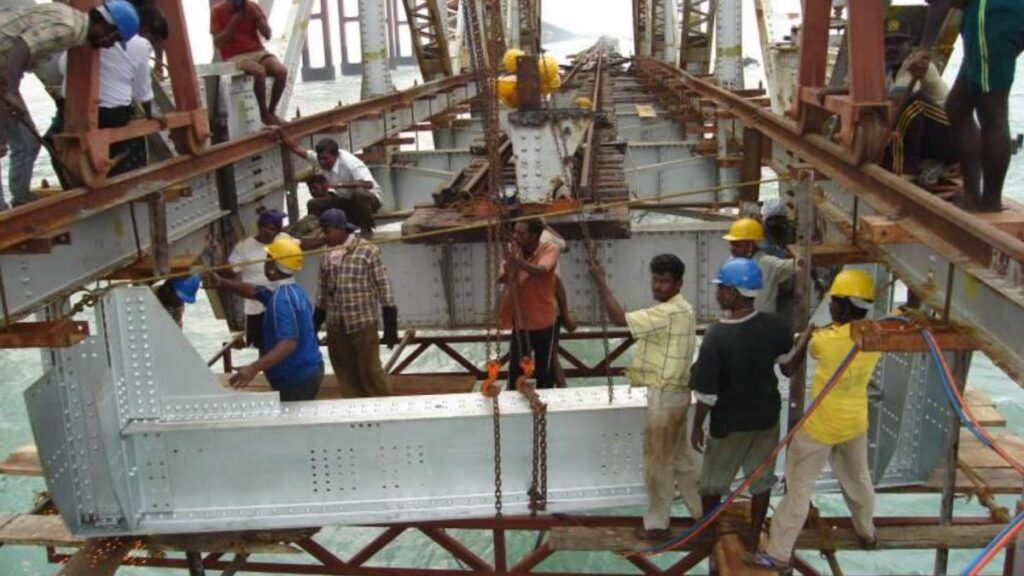But for the timely intervention and determination of a senior official of Railway Board, in all probability, train services to Rameswaram island through Pamban rail bridge could have been prematuredly stopped on the metre-gauge section in 2005.
For, the construction Wing of Southern Railway that had taken up gauge conversion between Madurai and Rameswaram decided to complete the work only up to Mandapam.
The officials of Construction Wing felt that gauge conversion of 225 feet of Scherzer span of the Pamban rail bridge, nearing 100 years of existence, would consume much time and thereby delay the gauge conversion project.
The double cantilever truss of 112.5 feet each was designed to open the bridge for facilitating navigation of ships on the Pamban channel.
Hence, the plan for terminating the rail services at Mandapam railway station within the mainland gained momentum.
“They wanted to make Mandapam railway station the new terminal to avoid taking up major modification in the British era Pamban rail bridge due to design and other technical issues,” the former Senior Divisional Engineer (Coordination) of Madurai Railway Division T. Archunan told The Hindu.
Railway officials went ahead with their plan even for land acquisition at Mandapam railway station for construction of railway yard, which meant that passengers would be forced to undertake a road journey for nearly 17 km to reach Rameswaram.
However, the then Railway Board Member (Engineering) Jarugar was keen on completing the gauge conversion work up to Rameswaram so that the benefit of the rail connectivity to the important pilgrimage centre of Rameswaram was not lost.
“He wanted to lay the broad-gauge railway line up to Rameswaram at any cost,” Mr. Archunan said.
Mr. Jarugar turned towards the engineers of Southern Railway. He asked whether the Zonal Bridge organisation could provide the design for gauge conversion of the Scherzer rolling lift span. He then posed the challenge to engineers of Madurai Division as to whether they could execute the bridge portion of the gauge conversion project.
“We took up the challenge though, in general, the mandate of the engineers of division is only to maintain the railway assets in good fettle for running of trains,” Mr. Archunan said.
Even as all the pillars and Scherzer span were strengthened, 15 of the old concrete girders were replaced with steel girders. For BG track, the contractor left midway after failing to carry on with the highly-technical work. The Herculean task literally fell on the railway engineers.
Railway workers involved in bridges wing from across India were mobilised for the work of fastening four lakh rivets on the steel bridge structure. The works included putting up additional members to the Scherzer span structures.
A small unit was set up on Pamban side to make the members and drill holes. “Though the rivets look very small, they are the ones that hold the entire structure together,” Mr. Mr. Archunan added.
Each rivet was heated by the workers at the base of the bridge on the railway track. They were lifted to the top of the bridge structure quickly so that the red hot rivets do not get cool down in the windy environment before they are compressed.
Besides, the work of setting in four lakh rivets and balancing the counter weight was very challenging, he added. Due to space constraints in the lifting span, engineers came up with cast iron blocks to increase the counter weight, instead of the old concrete blocks.
Though old piers were good enough for gauge conversion, the pier caps that were inadequate for broad-gauge tracks were widened and strengthened to withstand higher payload.
During the strengthening work, only those girders which were beyond repair were replaced with newer ones fabricated by Arakkonam engineering workshop. Rebracing by welding was done to the rest of the girders, Mr. Archunan added.
The highlight of taking up this challenging task was that the same set of engineers from the division had to simultaneously look after the regular maintenance of railway tracks and bridges across the sprawling network of Madurai division.
After two years of hard work, the engineers restored the rail connectivity to Rameswaram. Trains started to chugg on the bridge to reach Rameswaram after the broad gauge line was commissioned in August 2007.
This strengthening effort kept the steel bridge in good fettle in the world’s second most corrosive environment for the next 15 years, with time-to-time maintenance.
The British-era bridge completed a 100 years of existence and the centenary celebrations of the section, including the Pamban bridge, were held in 2014.
Published – April 04, 2025 09:24 pm IST
Source:https://www.thehindu.com/news/cities/Madurai/madurai-divisional-engineers-saved-british-era-pamban-rail-bridge/article69413631.ece

